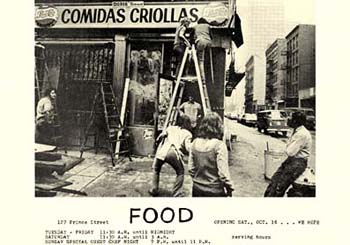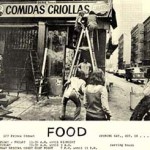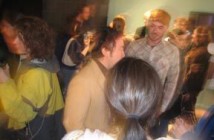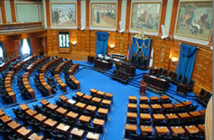Contemporary Fine Artists are unconsciously and strategically placed in the position of an economical base for a multi-billion dollar industry. Veiled by way of ideology, Art maintains earning an actual income convincingly impossible for the Artist. Self-actualizing one’s labour, raising questions about social positions, collectively researching and separating out a compounded history for visibility (as opposed to perpetuating humble contributions) are all difficult tasks. But, perhaps tasks worth considering.
For encouragement, keep this in mind:
“Marx conceived the structure of every society as constituted by ‘levels’ or ‘instances’ articulated by a specific determination: the infrastructure, or economic base (the ‘unity’ of the productive forces and the relations of production and the superstructure…) and ideology… Like every metaphor, this metaphor suggests something, makes something visible. What? Precisely this: that the upper floors could not ‘stay up’ (in the air) alone, if they did not rest precisely on their base.” [1]
To begin with, who does America consider its Artists to be? In 2003, The Artist Labor Force had been described by the Department of Labor (by way of the NEA) as consisting of these groups: Architects, Art Directors, Fine Artists, Animators, Designers, Actors, Producers and Directors, Dancers and Choreographers, Musicians and Singers, Announcers, Writers and Authors, Photographers and Other artists and entertainers.
Such a broad definition of “Artist”, an absorption, is problematic mainly because it interrupts any solid documentation of what a Contemporary Fine Artist earns through Artwork, affecting statistics that could be used as leverage to make demands against a multi-billion dollar industry that barely incorporates its labour force.
Georg Lukacs iterates and forewarns:
"For if from the vantage point of a particular class the totality of existing society is not visible; …then such a class is doomed to play only a subordinate role.“ [2]
Because Contemporary Fine Artists are not visible in their own category, it’s hard to tell what they are generating in income and if their income is coming from Artwork. According to the U.S Department of Labor in 2003, Fine Artists’ Mean Annual Wage Estimate (including Painters, Sculptors, and Illustrators) was roughly 49K. This was from Artists who claim “Artist” as their primary job; this was also from a household average.
Most Contemporary Fine Artists are not earning a living by way of their Artwork. Instead, they are moonlighting to make ends meet. When asked by census we will more than likely claim “Artist” because we are self-identified as such, not necessarily because it employs us. Few will consider, “Barista” as their defining job, for example, even though it pays the rent. In 2003, the unemployment rate for ‘Artists’ was 2.9 percentage points higher than the rate for professional workers as a whole. The NEA also notes that in 2003, “the BLS reports that 7.3 million workers, or 5.3 percent of the employed, were multiple jobholders. But, as the BLS occupational data show, the multiple jobholding rate for ‘Artists’ was more than twice the rate measured for all civilian workers.” [3]
Many Contemporary Fine Artists will rely, in some form or fashion on the non-profit sector. But we have to ask ourselves, whom are the non-profs really considering and where is their money going? The NEA is a federal agency and is advised by a Council (which has 14 members plus 6 more members of Congress) and determines where and how money is granted. The President of the United States, the Speaker of the House, the Minority Leader of the House, the Majority Leader of the Senate and the Minority Leader of the Senate variously appoint them. Two major shifts that Artists have felt from the NEA are of course censorship but also the cancellation of much needed individual grants for Artists.
“That is to say, the state is not a mediation of the economic control of society: it is the unmediated dominance itself. “ [4]
Bush said on April 22, 2002, at the ceremony honoring the recipients of the National Medal of Arts, that “the Arts are essential to preserving and celebrating our democratic way of life.” In the NEA’s Strategic Plan for 2003-2008, the Arts Endowment professes that “the arts ... belong to all the people of the United States.” Also, “Artists are among our Nation’s most important innovators and creators”. And, “The arts bolster our economy through expenditures by arts organizations and the participating public.” Further, “While most would agree with these observations, we know that creativity – like any other human endeavor – cannot flourish without sustenance.” [5]
Contemporary Fine Artists, while you are in your studios, or storing away finished pieces that haven’t shown or been bought – or even works that are showing and being seen by the public without a fee: Question “sustenance”! Question, “bolstering our economy”! Ask yourself, “Where are my wages for producing work that the Nation has deemed so valuable for today and for future generations and from which others profit and benefit?” Go buy a punch-clock for your studios and get agitated when the time comes to pay its rent and you need new materials.
Be aware:
"In capitalism these institutions merely imply the stabilization of purely economic forces so that…they frequently adapt themselves in form or content. By contrast, in pre-capitalist societies legal institutions intervene substantively in the interplay of economic forces. In fact there are no purely economic categories to appear or to be given legal form. …Economic and legal categories are objectively and substantively so interwoven as to be inseparable. …In Hegel’s parlance the economy has not even objectively reached the stage of being-for-itself." [6]
In the fiscal year 2004, the NEA was granted $120,971,000. This money is disseminated roughly to State and Regional programming, agencies and arts organizations. Not to individual Artists. They do give fellowships to Writers but for Visual Artists, we feel these donations in a roundabout way and in the form of exhibitions, magazines, galleries, workshops, residencies, studios - but not income.
I have no problem with the NEA, in and of itself. What they are doing and set up to do culturally is very important. What I have a problem with is that $120,971,000 is a lot of money to be spent on Art (proper) and so little is given to those who are making the Art.
All but the Fine Artists, actually have a union to represent their interests. Of the labor unions listed for Artists, there are: Actors’ Equity Association, American Federation of Musicians, American Federation of Television and Radio Artists, American Guild of Musical Artists, Directors Guild of America, The Dramatists Guild of America, International Alliance of Theatrical Stage Employees, Producers Guild of America, Screen Actors Guild and Writers Guild of America.
Who earns money from Art if not the Contemporary Fine Artist? To address a few, In 2002, the US Census Bureau reported that there were roughly 9000 established Fine Art Schools who generated approximately $2.2 Billion in receipts. Estimated established Art Dealers were 6000 in number and generated near $4.3 Billion in receipts. Basically 4500 established Museums generated about $5.9 Billion in receipts. (These figures combine both taxable and tax-exempt institutions.) Independent Artists, Writers and Performers’ head-count was roughly 570,000 with receipts a little more than $19.6 Billion. However, Independent Artists, Writers and Performers also included Athletes and Celebrities endorsing products and/or making speeches.
What does it do to the Contemporary Fine Artist, psychologically and socially, to essentially have her work seen, picked-through and fed upon with very little or no concrete, tangible, money-in-your-pocket returns? Art has produced another Ideological State Apparatus: we feel privilege and our desire to ‘make’ often out-ways our entitlement for an income. Art is something that we believe in regardless of any returns. We are humble contributors, but nonetheless exploited.
Ian Burn describes this conundrum well: “The artist alienates herself not only from her own labor power, but also from the products which her labor results in: Once my work of art enters the art market, it takes on a power independent of me and this strikes me as a form of estrangement from what I have produced, an alienation from my own experiences.” [7] While it may not be clear how we got here, what is certain is that we compete against each other within its murky structure; we accept our position within it from the onset; we judge success based on our inclusion (not payment).
Art, in all of its manifestations, mysteries, market, doesn’t have to work the way it does. We, the Contemporary Fine Artists, obey Art’s authority before ever stepping inside of it because we self-identify with a term, not with an employable skill. We are good at asking questions about and being critical of everything, but not of our own experience. We return to our condition time and time again; it exists a-priori; it is a trauma.
Let this condition inform us:
“There is always a residue, a leftover, a stain of traumatic irrationality and senselessness sticking to it, and that this leftover, far from hindering the full submission of the subject to the ideological command, is the very condition of it…in other words, which – in so far as it escapes ideological sense – sustains what we might call the ideological jouis-sense, enjoyment – in – sense (enjoy – meant), proper to ideology." [8]
We do have evidence in our own history when the contributing automaton is not present. However, the briefly cognizant effort is swiftly folded back into the structure, the products only becoming a part of Art discourse, problematized, footnoted in Art History.
Food was a restaurant that was not only owned and maintained by Artists, served the Artists food working on the establishment of 112 Greene Street, but was also meant to provide a wage to those artists in the meantime. Carol Goodden and Gordon Matta-Clark set up Food in 1971. To me it was a practical solution that can’t seem to be categorized appropriately. To the Guggenheim, it’s part of Gordon Matta-Clark’s repertoire: “He also collaborated on Food, a combined restaurant and performance piece”. To the Tate it was a conceptual piece, “one of Matta-Clark's most atypical instances of conceptual art." To Cabinet magazine, it became a matter of discourse “ which ranged from explorations of commerce and community.“ To Tropolism it was “an implicit critique of the displacement of manufacturing by the artists' lofts.” Perhaps more accurately, “Food was a restaurant and artist cooperative that was the catalyst of an economic and labour system self-managed by an artistic community that aspired to guaranteeing the survival of some 300 artists in the city.”[9]
Food is not Art. It is an example of absorption and turning an effort towards sustenance into discourse by the Art community. Food should spring-up again in every neighborhood across the country as a model to not be defeated because we still need it. As Goodden herself describes, it was a practical remedy in which Artists “could be free to suddenly drop out as needed to produce their show and still have a job when they were through”. [10] No doubt, Gordon Matta-Clark and others used the space for various explorations; he even made a film about it. But in my opinion, the restaurant was more of a means, and perhaps a material, but not Art. Intention is the difference; to labour, one must have intention.
works cited:
[1] Louis Althusser, "Ideology and the State", Lenin and Philosophy and other essays by Louis Althusser. New York: Monthly Review Press, 1971, p. 134-5
[2] Georg Lukacs, History and Class Consciousness: Studies in Marxist Dialectics. Cambridge, MA: The MIT Press, 2002, p. 52
[3] Bonnie Nichols, "Artist Employment in 2003", 2003 found at http://www.nea.gov/pub/Notes/87.pdf, 4/16/2006
[4] Lukacs, 56
[5] NEA, Strategic Plan 2003-2008, submitted to Congress February 2003. Found at http://www.nea.gov/about/Strategic/FY2003-2008StrategicPlan.pdf, 4/16/2006
[6] Lukacs, 57
[7] Olav Velthuis, Talking Prices: Symbolic Meanings of Prices on the Market for Contemporary Art, New Jersey: Princeton University Press, 2005, p. 25
[8] Slavoj Zizek, The Sublime Object of Ideology, New York: Verso Press, 1989, p. 37
[9] Peggy Thoeny, "Final Thesis 2003/4, Interaction Design." found at http://people.interaction-ivrea.it/p.thoeny/_Thesis/4rd_references_gordon_mattaclark.htm, 4/16/2006
[10] Martin Beck, "Alternative: Space", ed. Julie Ault, Alternative Art New York 1965-1985, Mnneapolis-London: University of Minnesota Press, 2002, p. 256
Links:
NEA
Boston Redevelopment Authority
Creative Economy





